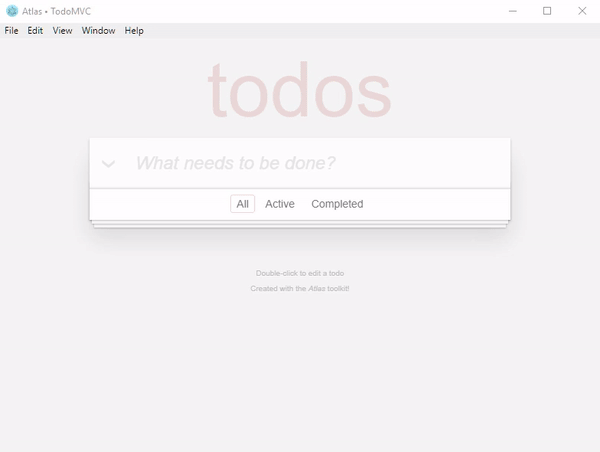The Atlas toolkit is available for:
If you are looking for the WebGPIO application, an application with which you can control the Raspberry Pi (or other similar devices) GPIO with your smartphone, you will find it at the bottom of this page, in the Raspberry Pi/ODROID-C2 section.
Straight to the point: the Hello, World! program
import atlastk as Atlas
body = """
<div style="display: table; margin: 50px auto auto auto;">
<fieldset>
<input id="input" maxlength="20" placeholder="Enter a name here" type="text"
data-xdh-onevent="Submit" value="World"/>
<div style="display: flex; justify-content: space-around; margin: 5px auto auto auto;">
<button data-xdh-onevent="Submit">Submit</button>
<button data-xdh-onevent="Clear">Clear</button>
</div>
</fieldset>
</div>
"""
def acConnect(dom):
dom.setLayout("", body)
dom.focus("input")
def acSubmit(dom):
dom.alert("Hello, " + dom.getContent("input") + "!")
dom.focus("input")
def acClear(dom):
if ( dom.confirm("Are you sure?") ):
dom.setContent("input", "")
dom.focus("input")
callbacks = {
"": acConnect, # The action label for a new connection is an empty string.
"Submit": acSubmit,
"Clear": acClear,
}
Atlas.launch(callbacks)Thanks to Replit, an online IDE, you can write and run programs using the Atlas toolkit directly in your web browser, without having to install Python on your computer.
To see some examples, like the following TodoMVC application or the above Hello, World! program, simply:
- go here (or click on the
badge at the top of this page),
- click on the green
runbutton, - select the demonstration you want to see,
- click (or scan with your smartphone) the then displayed QR code.
git clone http://github.com/epeios-q37/atlas-python
cd atlas-python/examples
python Hello/
If you want to:
- take your code to the next level, from CLI to GUI,
- teach your students to program a GUI,
- impress your teacher with a blowing GUI,
- easily share your programs with all you family and friends,
then you found the right toolkit.
With the Atlas toolkit, writing modern web applications (SPA) has never been this easy:
- no JavaScript to write; only HTML and Python,
- no front and back end architecture to bother with,
- no web server (Apache, Nginx…) to install,
- no need to deploy your application on a remote server,
- no incoming port to open on your internet box.
The Atlas toolkit is written in pure Python, with no native code and no dependencies, allowing the Atlas toolkit to be used on all environments where Python is available.
Simply by running them on a local computer with a simple internet connexion, applications using the Atlas toolkit will be accessible from the entire internet on laptops, smartphones, tablets…
The Atlas toolkit is particularly well suited for educational purposes, to write modern programming exercises, i.e. with a true graphical interface instead of the usual outdated textual one. More about this can be found here.
There is also a stub to for this library at address https://q37.info/s/zzcn3wnx.
The atlastk directory contains the Python source code of the Atlas toolkit, which is the directory you have to reference in PYTHONPATH in order to use the Atlas toolkit in your own program, unless you have installed the atlastk package with pip install atlastk.
In the examples directory, you will found following examples:
- Blank: very basic example,
- Hello: "Hello, World!",
- Chatroom: multi-user chatroom,
- ReversiTXT: Reversi game with
XandOfor token, - Notes: note taking program,
- TodoMVC: TodoMVC,
- Hangman: Hangman game,
- 15-puzzle: 15-puzzle game,
- ReversiIMG: Reversi game with more evolved graphics,
- ReversiXSL: Reversi game using XSL.
Other examples are detailed in the next section.
Except for the ErgoJr, GPIO and RGB applications, which are detailed in the next section, to run an example, launch, from within the repository, python main.py, and select the example you want to run. You can also directly launch, from within the examples directory, python <Name>/ (don't forget the final /), where <Name> is the name of the example (Blank, Chatroom…).
The Stars application is an example where the Atlas toolkit is used to control a Pygame based application. Of course, Pygame needs to be installed.
If the applications does not work on your Raspberry Pi, please see this issue: epeios-q37#1
The GPIO and RGB applications are designed to be used on a Raspberry Pi or a ODROID-C2.
For the Raspberry Pi, the RPi.GPIO Python module have to be installed (this is probably already the case).
For the ODROID-C2, The Python version of WiringPi must be installed, and the application has to be launched, from within the examples directory, with sudo (sudo python GPIO/ or sudo python RGB/).
The ErgoJr application is experimental and to control a Poppy Ergo Jr robot.
The RGB application is dedicated to the control of a RGB led, and the GPIO (aka WebGPIO) application allows to control the basic pins. Here is a video to see how they works:
Same video on PeerTube : https://peertube.video/videos/watch/e7e02356-c9c3-4590-8ec0-8f8da06ff312









